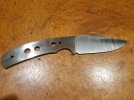- Joined
- Jul 2, 2009
- Messages
- 1,176
Hey all – I have been making fairly quick personal progress improving in my hobby knife making over the last month or so, but I continue to struggle getting past what I will call a quite “rustic look”. I have made huge personal strides in most everything outside of this area. I have progressed from totally uncomfortable/useless knives to comfortable/functional (but rustic knives), but the progress seems to have really slowed. Any suggestions or advice on how to get over this plateau for a beginner? I do and love rustic knives but would like to be capable of making something beyond this over time. Any suggestions on easy adjustments to materials or design/finish? I know much of this will come in time, but any help would be great. Thanks all.
(FYI - I have used both the knives in the photos so not all the scratches are my finish work but the overall look is the same rustic look).
(FYI - I have used both the knives in the photos so not all the scratches are my finish work but the overall look is the same rustic look).

